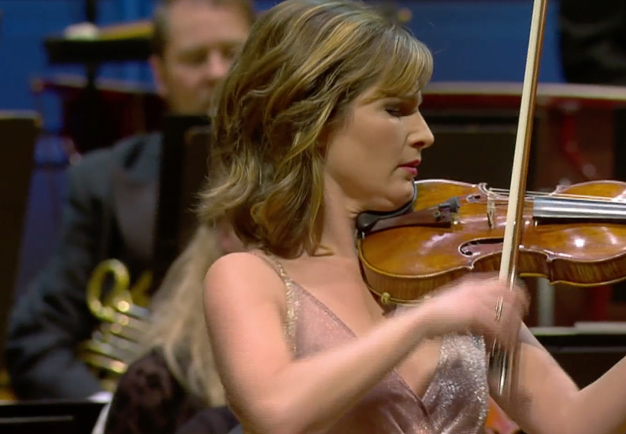Violin Concerto

Lisa Batiashvili plays the Violin Concerto on May 26
Sibelius’ dreams of becoming a violin soloist were transformed into what became a much-loved violin concerto.
Jean Sibelius’ Violin Concerto has been performed 117 times in its entirety by the Royal Stockholm Philharmonic Orchestra. The first time was on 16 April 1914 with Julius Ruthström as the soloist and Erich Ochs conducting. Sibelius led the Violin Concerto with the Royal Stockholm Philharmonic Orchestra on one occasion: 24 March 1924. Julius Ruthström was the violin soloist on that occasion as well. At the same concert, Sibelius conducted his Symphony No. 1 and the world premiere of Symphony No. 7.
Jean Sibelius
Violin Concerto in D minor, Op. 47 (1904/rev. 1905)
Allegro moderato
Adagio di molto
Allegro ma non tanto
Durata approx. 31 mins.
The Violin Concerto from 1904/05 is usually called Sibelius’ last major orchestral piece in the National Romantic style, but 2it is also paired with a genre – the solo concerto – traditionally characterised by outward virtuosity. Sibelius, himself a violinist, may well have written the concerto he himself would have liked to play – albeit at a level of playing technique that was far above his own. In this sense, the Violin Concerto can be seen as a farewell to his youthful dreams of a career as a violin virtuoso. It is one of the more challenging in its genre, as many violinists have testified.
His wife, Aino Sibelius, has described the inspired work that went on day and night in the winter of 1903-04.
“Janne has been in the throes of it all the time (and so have I), and again it has been an embarrass de richesse, with too much to choose between. He has been assailed by such a multitude of motifs that he has become quite literally dizzy. He keeps watch all night long, plays incredibly beautifully, unable to break free from these enchanting notes – he has so many ideas, it is truly astonishing.”
It was indeed inspired composing, but the concerto’s life on the concert stage did not start well. It was originally intended for the then renowned virtuoso Willy Burmester. But Sibelius was, as usual, in need of money and the premiere had to be rushed, so Viktor Novácek gave the first performance in February 1904. Novácek did not have much time to learn the difficult solo part, and the premiere was not a great success. Critics said that Sibelius had ”succumbed to conventional virtuosity”.
After the disappointing premiere in 1904, Sibelius decided to revise and tighten the piece. The final version of the Violin Concerto was performed in Berlin in autumn 1905, with Karl Halir as the soloist and Richard Strauss conducting. Burmester – who initiated the commission and was originally promised the world premiere, and who called it “masterful” when he saw the score but asked for extra time to rehearse it – thus saw his artistic pride wounded for the second time. Incidentally, there was to be a third time: when the revised Violin Concerto was published, it was dedicated to Ferenc von Vecsey, the then 12-year-old Hungarian violinist who discovered it early on and included it in his repertoire, and who also performed it with the Royal Stockholm Philharmonic Orchestra on a few occasions around 1920. Perhaps needless to say, Burmester never actually performed the piece.
But then the worldwide triumph began: Sibelius’ Violin Concerto is now the most widely played of all the violin concertos of the 20th century (although you can of course argue that it stylistically belongs to the late 19th century).
The music is warm and lyrical, dramatic and melancholic. The first movement is expansive – as long as the other two combined (in the original version it was even longer). The soloist immediately enters the action to delightfully whirring strings, and the solo part is filled with challenging virtuosity. The movement contains two solo cadenzas: the first occurs early on, while the second and most brilliant is placed at the centre of the movement.
The slow middle movement sings expressively in a Romantic style, often with the soloist resting intimately against the gasping orchestra. But the music doesn’t lose its drama even here, and at times it sweeps the whole orchestra forward in broad surges.
A “polonaise for polar bears” was how British musicologist Donald Tovey described the finale. That might well be what he saw before him in the buoyant and almost folk-like music that is played there. The violinist dances to the orchestra’s persistent rhythms – in the words of Sibelius’ biographer Erik Tawaststjerna it’s like incantations – and a close interplay between orchestra and soloist is carved out in the powerful and intense music.
Tony Lundman
